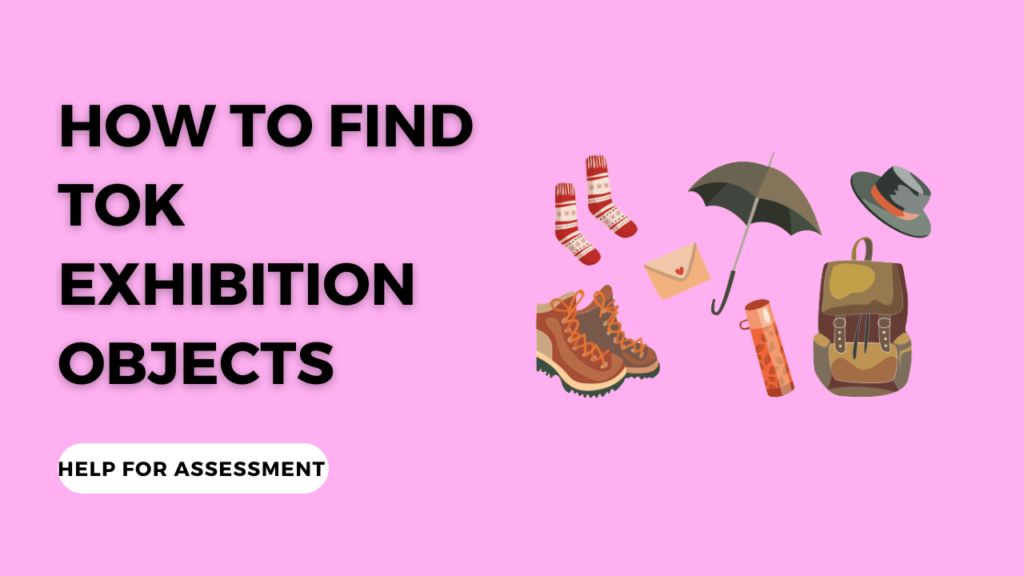We’ve provided a detailed guide on the TOK Exhibition Objects for IB students already. So we won’t go over that in this lesson. Instead, we’ll look at how to find the three objects for the TOK Exhibitions in the shortest time possible.
The International Baccalaureate makes significant changes to its program every seven years to improve the way teachers and students look at education.
And the TOK Exhibition is the new task introduced in 2022 in place for the TOK Presentation.
First, let us make sure you understand what Theory of Knowledge Exhibition objects are as well as what counts as an object.
What are TOK Exhibition Objects?
In TOK, an object is a product of knowledge with a real-world context. According to IB, different types of objects are suitable for the TOK Exhibition, although this holds only if the objects are neither symbolic nor generic.
While you can choose any object you like for the Exhibition project, it’s best to pick options that are of your personal interest, especially if you have come across them in your academic studies or outside the classroom.
To find the right objects to explore, it’s best to first base your exhibition on one of the themes.
You can base it on the core theme or on one of the optional themes. Doing so makes it easy for you to not only narrow down and pick relevant objects but also give a better, clear focus on your exhibition.
Get TOK Exhibition Help
The team at Help for Assessment includes IB experts from whom you can get help for your ToK Exhibition. We will help you do everything from selecting objects to preparing your presentation files.
What Counts as a TOK Exhibition Object?
Before we look at how you can find the three TOK exhibition objects, it’s important to know what counts as an object in the first place.
According to the TOK Exhibition guide, an object can be physical or digital. However, for that product of knowledge to count as an object, it must:
- Have a concise real-world context
- Exist in a particular place and in a specific time and
- Be very specific in kind
To be very precise, the three objects you choose must have pre-existed to include a real-world context. Keep this in mind especially when coming up with objects that you have created yourself.
You’re welcome to ask your Theory of Knowledge teacher about the kind of objects that are relevant for your IA prompt and the exhibition commentary.
Your teacher will provide insightful written or oral feedback on the draft of your commentary. The information they provide can be quite useful in helping you score the full marks for your exhibition assignment.
How to Find the Three TOK Exhibition Objects
Here are few hints that will help you find the three best objects to include in your TOK commentary.
1. Pick Objects with Specific, Real World Context
The objects you choose to include in your Theory of Knowledge commentary can’t be hypothetical or generic.
You have to state the space in which the objects exist, which can be either digital or physical.
Also, you must indicate the date in which the objects existed, otherwise you can’t consider them to be objects with specific real-world context.
The IB guide recommends that you discuss the three objects within the core or optional themes taught in the Theory of Knowledge.
Having this link isn’t mandatory and your teacher won’t asses you for it. However, relating your objects to either of the themes will make it easy for you to develop a clear context that you can use to write a clear commentary.
2. Your TOK Exhibition Objects Don’t Have to Relate to Each Other
You don’t have to relate your TOK objects to each if doing so will make it hard for you to write a good commentary.
Instead, pick three objects independent of each other and treat the commentary as three separate paragraphs of 290 to 300 words each.
As long as your objects (or images of objects) are specific in kind, exist in time, belong to a specific space, and relate to a core or an optional theme, you have yourself the right objects for the commentary.
Feel free to interlink your objects to each other if you want to, but this isn’t something your TOK teacher will assess your commentary for anyway.
3. Your Objects Can Be either Digital or Physical
The TOK exhibition guide allows you to choose either a digital or a physical object for your commentary. It’s important to note that these are the two spaces within which the objects exist.
A physical object refers to the photo of an actual building and a digital object can be a digital version of an actual object or an object created digitally (such as a tweet by Donald Trump or an email).
Although you can create a digital or physical object yourself, they cannot be specifically for the exhibition purposes.
4. Can You Justify the Exhibition Objects You’ve Chosen?
If you cannot show a strong justification of your choice of one or all objects, then you should consider replacing it with an alternative.
While your objects don’t exactly have to have a link to each other, they must be relevant to your IA prompt. It also helps if you have a personal interest in the objects, especially if they’ve had a significant impact in your life.
5. TOK Objects and TOK Concepts
It’s important to make sure that the images you have identified allow you to draw on the 12 Key TOK Concepts. There are two advantages to this. First, the concepts strengthen your exhibition’s commentary. Second, it easily shows how the Theory of Knowledge manifests itself in the world outside your classroom.

